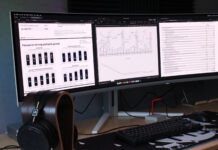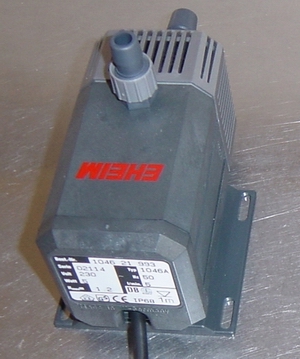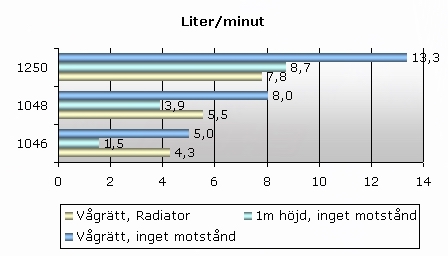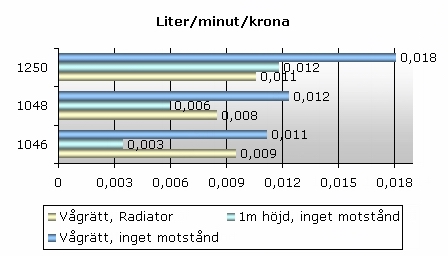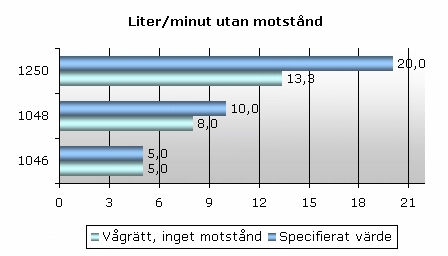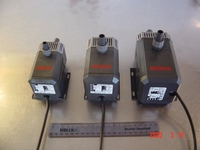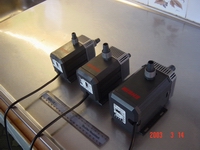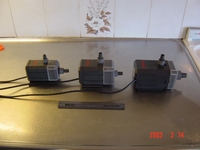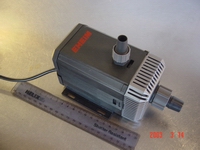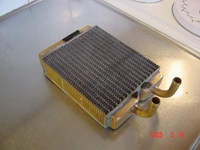Today’s processor cores are getting smaller and smaller while the number of transistors are increasing rapidly. As the speed of the processor increase at the same time, so does the heat dissipation, and the result is a higher heat dissipation per area unit. This and the increasing heat dissipation has through the years contributed to the evolution within the cooling PC needs, from completely passive aluminum heatsinks, to very small aluminum coolers with fans, to large aluminum heat sinks with fans, to active aluminum heatsinks with copper cores with fans, to pure copper coolers, moving on to even more exotic things such as heatpipes, water cooling, peltier and even compressor cooling and phase change.
A water cooling system is as you perhaps know composed out of 7 different components: water block, radiator, fan, hose, water, perhaps a reservoir and a pump. The components we have taken a closer look at today is the last mentioned; pumps, and these ones have been made by the renowned company Eheim. Three to be a bit more precise, to be exact we’re talking about the 1046, 1048 and 1250 models.
|
Specifications: Eheim 1046
|
|
|
Performance
|
|
| Flow |
300l/h, 5l/min, 83,3ml/s
|
| Pressure height |
1,2m
|
|
Power
|
|
| At 230V/50Hz |
5W
|
| At 220V/50Hz |
4,8W
|
|
Measurements
|
|
| Exterior |
145 x 75 x 103mm
|
| Diameter intake |
Ø13mm (1/2")
|
| Diameter out take |
Ø9,5mm (3/8")
|
| Nipple in |
Ø9,5mm (3/8")
|
| Nipple out |
Ø7mm (1/4") |
The small size brings some drawbacks of course, it doesn’t pump all that much water and quickly drops the rate when you increase the resistance or height. The worst is however the hose connections, the diameters Eheim specifies are the measurements of the holes, but in the holes you have to (in the out take) screw in the hose connections. The connections are partly cone-shaped, and limits the flow. Even if Eheim writes 11mm out take, the hose connection makes it more like 7mm. You can use 1/2" hose by squeezing the hose over the entire connection, but this is not a durable solution as the risk for leakage is pretty big.
You might wonder if there are any suitable areas of use for such a small pump, and there is of course. There are plenty of retail water cooling systems which use even smaller pumps, exchanging them for a reliable pump by Eheim might be an option. If you want to use several loops, one separate for an extra radiator, or for an extra water block, e.g. GPU or NB, it’s relatively easy to fit a 1046 inside the case. On the other hand it is cheaper and easier to run two loops in parallel with a bigger pump, but we are all different and want different things.
|
Specifications
|
||
| We look at the product’s interior and exterior properties, and how they affect the possible areas of use there is. |
|
|
1046 is one of Eheim’s smallest pumps, and it is pretty obvious when you check out the specifications. 1046 has a very small engine, making it relatively quiet and free from vibrations. And it doesn’t get very hot either, which in affects the water temperature, if anything by a small margin. It is smaller than the other two, which makes it easier to fit inside a reservoir.
|
Size/Noise
|
||
| We look at how the product’s vibrations, size, level of noise is experienced. |
|
|
|
Specifications: Eheim 1048
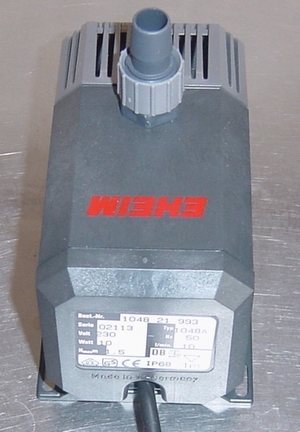 |
|
|
Performance
|
|
| Flow |
600l/h, 10l/min, 166,6ml/s
|
| Pressure height |
1,4m
|
|
Power
|
|
| At 230V/50Hz |
10W
|
| At 220V/50Hz |
9,6W
|
|
Measurements
|
|
| Exterior |
147 x 75 x 118mm
|
| Diameter intake |
Ø13mm (1/2")
|
| Diameter out take |
Ø13mm (1/2")
|
| Nipple in |
Ø9,5mm (3/8")
|
| Nipple out |
Ø9,5mm (3/8") |
1048 performs pretty well when we introduce some resistance or heights, probably enough to please most people, but perhaps not the extreme overclockers.
We feel that 1048 is pretty ok pump, is is better than 1046, but of course not as good as 1250.
|
Specifications
|
||
| We look at the product’s interior and exterior properties, and how they affect the possible areas of use there is. |
|
|
1048 is a pump in Eheim’s mid segment, and pretty popular to use with water cooling systems. Even if the engine is bigger than the one used with 1046 it is still pretty quiet and relatively free from vibrations.
With its 10W its not a big load for the radiator either, it doesn’t generate enough heat to cause any problems.
|
Size/Noise
|
||
| We look at how the product’s vibrations, size, level of noise is experienced. |
|
|
|
Specifications: Eheim 1250
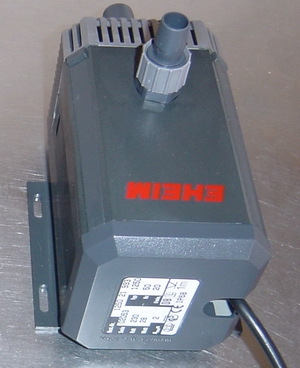 |
|
|
Performance
|
|
| Flow |
1200l/h, 20l/min, 333,3ml/s
|
| Pressure height |
2m
|
|
Power
|
|
| At 230V/50Hz |
28W
|
| At 220V/50Hz |
26,8W
|
|
Measurements
|
|
| Exterior |
180 x 95 x 120mm
|
| Diameter intake |
Ø17mm (3/4")
|
| Diameter out take |
Ø13mm (1/2")
|
| Nipple in |
Ø13mm (1/2")
|
| Nipple out |
Ø9,5mm (3/8") |
This is the pump we like the best of the three, and if you’re going for a serious water cooling system, but still wants to keep the price reasonable this is the pump to go for.
There are some interesting alternatives such as Hydor Seltz L30 which costs less and are available at some aquarium stores, alas we weren’t able to get a hold of one for this test.
|
Specifications
|
||
| We look at the product’s interior and exterior properties, and how they affect the possible areas of use there is. |
|
|
1250 is far from the biggest pump Eheim sells, but it is about as big, expensive and powerful as you will need. It has a bigger engine than the two preceding pumps, and sure it vibrates and sounds a bit more than the other, but still find it quite quiet.
1250 is way too big to put in a reservoir, at least if you want to keep the reservoir inside midi tower. It stands pretty well on the floor of a chassi, especially if you attach the skids to the floor, preferably with something soft beneath.
|
Size/Noise
|
||
| We look at how the product’s vibrations, size, level of noise is experienced. |
|
|
We have run three different tests with the pumps, but we might add more later.
We’ve used 1/2" hose with all pumps, about 1 meter (3 ft). it is possible that the smaller pumps would have performed better with a narrower hose in the height test, but then they would have done worse in the other tests.
The three tests we done are as follows:
-
Water flow without resistance, at even altitude
-
Water flow without resistance, at 1 meter altitude.
-
Water flow with radiator (heatercore/big momma) at even altitude
For all tests we’ve measured the time it took to fill a 10 liter bucket. We tested with and without the limiting intake nipple, but surprisingly enough we didn’t notice any differences in the results.
|
|
Here we see a few things, not all that surprising that e.g. the largest and most expensive pump is the one that performs best. Besides, it’s a lot better at handling heights.
We see that the radiator is a bigger limitation for larger pumps, together with a water block and at half a meter altitude we will see a quit significant drop in the flow compared to with no height difference or resistance.
|
This graph was mainly constructed to give you a hint of what you get for your money, there is really no reason to use so many decimals. The prices are based on Akvarielagunen’s prices. Akvarielagunen keeps a very competitive price with 1250 and 1046, while 1048 is a bit more expensive than other stores.
We see that 1250 offers the most value, but also that a 1046 with a radiator offers better flow than a 1048. You should also consider the small altitude which there is with a water cooling system, and then 1046 is surpassed by the 1048. It’s hard to set a grade for the price, 1250 is expensive, but offers the most value. 1046 is cheaper, but then has less actual value. You simply have to take a close look at what you really need, and none of these pumps are especially cheap nor offers good value according to us, even if 1048 looks to offer a good price performance ratio.
|
Incredibly enough 1046 performs exactly as specified, however 1048 and especially 1250 is having a hard time living up to the specified figures. 80 and 66% is not very good in a system which consists out of one meter hose with larger diameter than you would usually use with these pumps, and besides the hose was completely horizontal during the tests.
The ruler on the pictures is 20 cm to give you hint of how big the pumps are.
|
|
|
|
|
|
|
|
Price/availability
|
|
|
How much water the pumps pimp per buck and how easy they are to come by.
|
|
| Eheim 1046 |
7.5/10
|
| Eheim 1048 |
7.0/10
|
| Eheim 1250 |
6.5/10
|
|
Performance
|
|
|
How much water the pumps pump and how they perform compared to the specifications.
|
|
| Eheim 1046 |
6.0/10
|
| Eheim 1048 |
7.0/10
|
| Eheim 1250 |
8.0/10
|
As the three pumps are neither in the same price no performance segment it’s a bit of chore picking a winner.
1046 is too small to be of any greater use in a bigger, more demanding and efficient cooling system, it also costs way too much compared to what you get. If you want to exchange the pump of your e.g. Koolance system it is enough though.
1048 was popular a few years back, and still is to some degree. Today so called heatercores are getting more and more popular, which means a bigger load on the pump compared to traditional radiators. Furthermore more restrictive water blocks are getting more common, and with its comparably weak performance 1048 is to us not a safe investment for the future.
1250 finally, is powerful, but also big and expensive. Big brother 1060 would be preferred performance wise, but it is also even bigger and even more expensive.
If you check out the current trends we see that many are moving away from pumps with high specified flow to pumps that can deliver a higher pressure.
In a water cooling system there is a resistance which depends on the diameter of the hose, the radiator and the water block. As you saw on the last page all pumps have a PQ curve, and how much water that flows through the system depends on much water the pump can handle at a certain resistance.
In real life you can compare this to e.g. cars and tractors. If a few meters of hose without any vertical rake is a motorway Eheim is the winner, "the car ", as it has a plane PQ curve. But a system with a heatercore and new water block is considerably more demanding than a motorway, it is muddy field. As you now a car is fast on the motorway, but with muddy fields you don’t need fast cars, you need powerful tractors, with a steep PQ curve, I.e. it is capable of pumping a lot even with resistance.
The point is that that this series of products is getting old and outdated, we don’t need pumps that can pump 1200 l/h (or 798 which we measured) in a very free system, but can only handle 468 l/h with one single radiator. We prefer pumps that can pump700 l/h in free system, and 600 l/h with a radiator. But then again you should consider that Eheim didn’t design and constructed these pumps with water cooling in mind, but for aquariums without any resistance in the system.
You might have noticed the two values pressure height and flow in the specifications? Pressure height is what you should be comparing, not low. A steep PQ curve simply. These kind of pumps are however a bit more tricky to come by.
When rounding of the best choice in this roundup is Eheim 1250 .
|
|
|
||||||||||||||||||||||||||||||||||||||||||||||||
We would like to thank Akvarielagunen who made this review possible!







